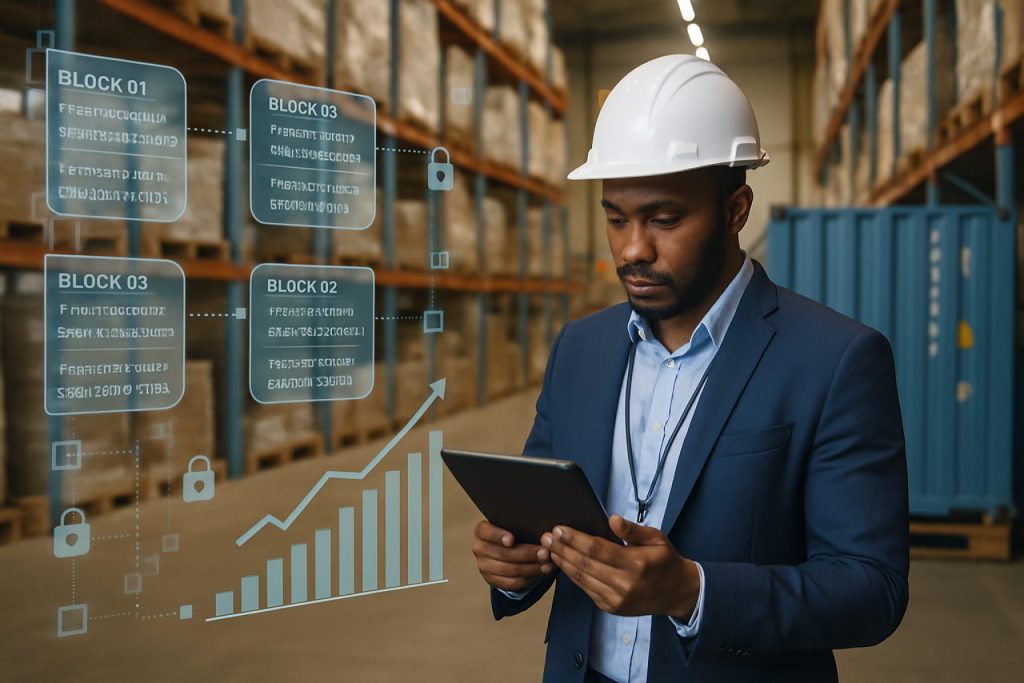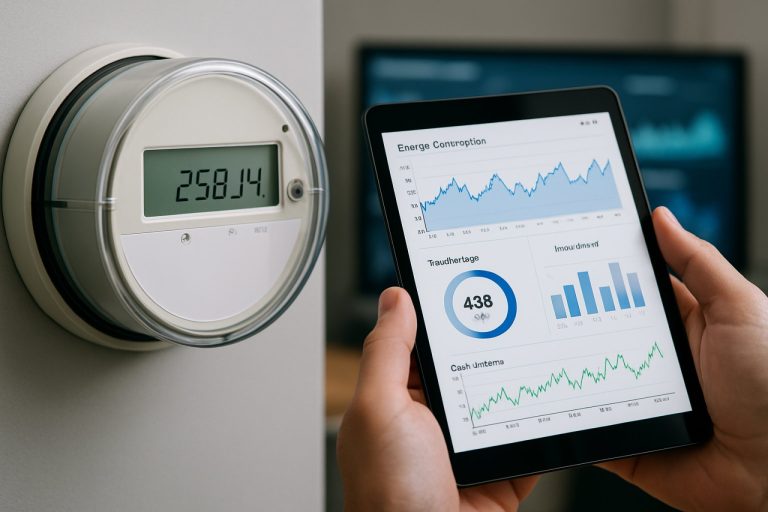
How Blockchain-Based Logistics Optimization Will Transform Global Supply Chains in 2025. Explore the Technologies, Market Growth, and Strategic Shifts Driving a New Era of Efficiency and Trust.
- Executive Summary: Blockchain’s Disruptive Impact on Logistics (2025–2030)
- Market Size & Forecast: Blockchain Logistics Solutions (2025–2029)
- Key Drivers: Transparency, Security, and Cost Reduction
- Technology Landscape: Leading Blockchain Platforms and Integrations
- Case Studies: Real-World Deployments by Industry Leaders
- Competitive Analysis: Major Players and Strategic Partnerships
- Regulatory Environment and Industry Standards
- Challenges and Barriers to Adoption
- Future Outlook: Emerging Trends and Innovations (2025–2030)
- Strategic Recommendations for Stakeholders
- Sources & References
Executive Summary: Blockchain’s Disruptive Impact on Logistics (2025–2030)
Between 2025 and 2030, blockchain technology is poised to fundamentally reshape logistics optimization, driving transparency, efficiency, and trust across global supply chains. As the logistics sector faces mounting pressure to address inefficiencies, fraud, and fragmented data flows, blockchain-based solutions are rapidly gaining traction among leading industry players and consortia.
In 2025, several major logistics providers and technology companies are actively deploying blockchain platforms to streamline operations. A.P. Moller – Maersk, the world’s largest container shipping company, continues to expand its blockchain-enabled TradeLens platform, which digitizes documentation and provides real-time shipment visibility. TradeLens, developed in partnership with IBM, has already processed millions of shipping events and is being adopted by port operators, customs authorities, and freight forwarders worldwide. Similarly, DHL is piloting blockchain-based track-and-trace solutions to enhance the integrity of pharmaceutical and high-value goods shipments, aiming to reduce counterfeiting and improve regulatory compliance.
Automotive and retail supply chains are also embracing blockchain for logistics optimization. Volkswagen Group is leveraging blockchain to trace the provenance of raw materials, such as cobalt, ensuring ethical sourcing and end-to-end transparency. Meanwhile, Walmart has implemented blockchain-based food traceability systems, reducing the time required to track produce origins from days to seconds, which significantly enhances recall efficiency and food safety.
Industry-wide initiatives are accelerating standardization and interoperability. The British Standards Institution and the GS1 standards body are collaborating with logistics stakeholders to develop frameworks for blockchain data exchange, ensuring seamless integration across diverse platforms. The International Federation of Freight Forwarders Associations (FIATA) is also piloting blockchain-based electronic bills of lading, aiming to reduce paperwork and fraud in international trade.
Looking ahead, the outlook for blockchain-based logistics optimization is robust. By 2030, widespread adoption is expected to deliver substantial cost savings, faster dispute resolution, and improved sustainability through automated carbon tracking and smart contracts. As regulatory clarity improves and interoperability standards mature, blockchain is set to become a foundational technology for resilient, transparent, and agile global logistics networks.
Market Size & Forecast: Blockchain Logistics Solutions (2025–2029)
The market for blockchain-based logistics optimization is poised for significant growth between 2025 and 2029, driven by increasing demand for transparency, traceability, and efficiency in global supply chains. As of 2025, adoption is accelerating among major logistics providers, shipping companies, and manufacturers seeking to address persistent challenges such as cargo fraud, paperwork bottlenecks, and lack of real-time visibility.
Key industry players are actively deploying blockchain solutions to streamline operations. A.P. Moller – Maersk, one of the world’s largest container shipping companies, continues to expand its blockchain-based TradeLens platform, which digitizes documentation and enables secure data sharing among shippers, ports, and customs authorities. Similarly, IBM collaborates with logistics and food supply chain partners to enhance provenance tracking and automate workflows using blockchain technology.
In the air cargo sector, Lufthansa Group and its subsidiaries are piloting blockchain for digital air waybills and cargo tracking, aiming to reduce manual errors and improve shipment transparency. Meanwhile, FedEx is investing in blockchain-based solutions to authenticate records and resolve disputes in real time, particularly for high-value and time-sensitive shipments.
The automotive and manufacturing sectors are also embracing blockchain for logistics optimization. Volkswagen Group has launched pilot projects to trace parts and materials across its global supply chain, ensuring compliance and sustainability. DHL, a global logistics leader, is integrating blockchain into its supply chain management systems to enhance shipment visibility and automate customs clearance processes.
Looking ahead to 2029, the market outlook remains robust. Industry analysts anticipate that blockchain-enabled logistics solutions will become increasingly standardized, with interoperability between platforms and broader regulatory acceptance. The proliferation of Internet of Things (IoT) devices and 5G connectivity is expected to further accelerate blockchain adoption, enabling real-time data capture and automated smart contracts for freight, warehousing, and last-mile delivery.
By 2029, blockchain-based logistics optimization is projected to be a core component of digital supply chain strategies for multinational enterprises, with measurable impacts on cost reduction, risk mitigation, and customer satisfaction. The continued investment and collaboration among industry leaders such as A.P. Moller – Maersk, IBM, DHL, and FedEx are expected to drive both technological innovation and market expansion in this sector.
Key Drivers: Transparency, Security, and Cost Reduction
Blockchain-based logistics optimization is rapidly gaining traction in 2025, driven by the sector’s urgent need for enhanced transparency, robust security, and significant cost reduction. The logistics industry, traditionally hampered by fragmented data silos and manual processes, is leveraging blockchain’s decentralized ledger technology to create immutable, real-time records of shipments, transactions, and compliance events. This shift is particularly evident among global supply chain leaders and major logistics providers.
Transparency is a primary driver, as blockchain enables all authorized stakeholders to access a single, tamper-proof version of the truth. For example, IBM and A.P. Moller – Maersk have continued to expand their TradeLens platform, which digitizes and shares shipping data across carriers, ports, and customs authorities. By 2025, TradeLens and similar platforms are processing millions of container events weekly, reducing paperwork and manual reconciliation. This transparency not only streamlines operations but also helps companies meet increasingly stringent regulatory and sustainability requirements.
Security is another critical factor. Blockchain’s cryptographic protocols protect sensitive data from unauthorized access and manipulation. In 2025, companies like DHL are piloting blockchain-based solutions to secure the provenance of goods, particularly in high-value and temperature-sensitive sectors such as pharmaceuticals and food. These systems ensure that every handoff and environmental condition is recorded and verifiable, reducing the risk of fraud, theft, and counterfeiting.
Cost reduction remains a compelling incentive. By automating trust and eliminating intermediaries, blockchain reduces administrative overhead and accelerates payment cycles. FedEx has reported ongoing trials of blockchain for dispute resolution in freight claims, aiming to cut down on costly delays and manual investigations. Smart contracts—self-executing agreements coded on the blockchain—are increasingly used to trigger payments and compliance checks automatically, further reducing transaction costs and errors.
Looking ahead, the outlook for blockchain-based logistics optimization is robust. Industry consortia and standards bodies, such as the GS1 global supply chain standards organization, are working to harmonize data formats and interoperability, which will accelerate adoption. As more logistics providers and shippers join blockchain networks, network effects are expected to drive even greater efficiencies, transparency, and security across global supply chains through 2025 and beyond.
Technology Landscape: Leading Blockchain Platforms and Integrations
The landscape of blockchain-based logistics optimization in 2025 is characterized by the maturation and integration of several leading blockchain platforms, each offering unique capabilities for supply chain transparency, traceability, and automation. As global logistics networks face increasing complexity and demand for real-time data, blockchain solutions are being adopted by major industry players to streamline operations, reduce fraud, and enhance trust among stakeholders.
One of the most prominent platforms is IBM’s Blockchain, which underpins the IBM Food Trust and is widely used in logistics and supply chain management. IBM’s blockchain solutions enable participants to share data securely and automate processes through smart contracts, with notable adoption by food distributors, shipping companies, and retailers. In 2024 and 2025, IBM has expanded its partnerships with logistics providers and port authorities, focusing on end-to-end visibility and compliance automation.
Another key player is A.P. Moller – Maersk, which, in collaboration with IBM, developed the TradeLens platform. TradeLens leverages blockchain to digitize shipping documentation and provide real-time access to shipment data for over 100 participants, including port operators, customs authorities, and freight forwarders. As of 2025, TradeLens continues to be a benchmark for blockchain-enabled logistics, although Maersk has announced a gradual transition towards more open, interoperable blockchain solutions to foster broader industry collaboration.
The GS1 standards organization, known for its global barcoding system, has been instrumental in driving blockchain interoperability. In 2025, GS1’s guidelines for blockchain data exchange are being adopted by logistics technology providers to ensure seamless integration between blockchain platforms and existing enterprise resource planning (ERP) systems. This standardization is critical for scaling blockchain adoption across multinational supply chains.
Emerging platforms such as VeChain Foundation are gaining traction, particularly in Asia and Europe, for their focus on product provenance and anti-counterfeiting in logistics. VeChain’s ToolChain platform enables companies to track goods from origin to destination, with real-time data accessible to all authorized parties. In 2025, VeChain is expanding its partnerships with automotive, pharmaceutical, and luxury goods manufacturers to enhance supply chain transparency.
Looking ahead, the next few years are expected to see increased convergence between blockchain and other technologies such as IoT and AI, further optimizing logistics operations. Industry consortia and standards bodies will play a pivotal role in ensuring interoperability and data integrity, while leading platforms continue to evolve to meet the demands of global trade and regulatory compliance.
Case Studies: Real-World Deployments by Industry Leaders
In 2025, blockchain-based logistics optimization has moved from pilot projects to real-world deployments by industry leaders, demonstrating tangible benefits in transparency, efficiency, and cost reduction. Several global corporations and consortia have implemented blockchain solutions to address persistent challenges in supply chain management, such as data silos, shipment traceability, and fraud prevention.
One of the most prominent examples is the A.P. Moller – Maersk and IBM collaboration on the TradeLens platform. TradeLens leverages blockchain to provide end-to-end supply chain visibility, enabling participants to securely share shipping data and documents in real time. By 2025, TradeLens has processed millions of container shipments, involving over 175 organizations, including port operators, customs authorities, and logistics providers. The platform has demonstrated a reduction in document processing times by up to 40%, and a significant decrease in administrative costs for its users.
Another notable deployment is by DHL, a global logistics leader, which has integrated blockchain into its pharmaceutical supply chain operations. DHL’s blockchain solution ensures the integrity and traceability of temperature-sensitive shipments, helping to combat counterfeiting and regulatory non-compliance. The system records every handoff and environmental condition, providing regulators and clients with immutable proof of compliance and product authenticity.
In the automotive sector, Volkswagen Group has partnered with suppliers and technology providers to implement blockchain for tracking the provenance of critical raw materials, such as cobalt, used in electric vehicle batteries. This initiative enhances supply chain transparency and supports responsible sourcing, aligning with growing regulatory and consumer demands for ethical materials.
Looking ahead, industry consortia such as the Blockchain in Transport Alliance (BiTA) are driving standardization and interoperability across logistics networks. BiTA’s members, including major carriers, shippers, and technology firms, are piloting blockchain-based smart contracts to automate freight payments and dispute resolution, aiming to reduce payment cycles from weeks to days.
The outlook for blockchain-based logistics optimization in the next few years is robust. As more stakeholders join these platforms and regulatory frameworks mature, the network effects are expected to amplify benefits, including real-time risk management, automated compliance, and enhanced sustainability reporting. Industry leaders’ successful deployments are setting benchmarks and accelerating adoption across the global logistics ecosystem.
Competitive Analysis: Major Players and Strategic Partnerships
The competitive landscape for blockchain-based logistics optimization in 2025 is characterized by a mix of established technology giants, logistics conglomerates, and innovative startups, all vying to redefine supply chain transparency, efficiency, and trust. Strategic partnerships and consortia are central to this evolution, as interoperability and network effects are critical for blockchain’s value proposition in logistics.
Among the most prominent players, IBM continues to lead with its blockchain platform, which underpins several high-profile logistics initiatives. IBM’s Food Trust and TradeLens (the latter developed in partnership with A.P. Moller – Maersk) have set benchmarks for blockchain-enabled supply chain visibility, though TradeLens announced its discontinuation in late 2022. Nevertheless, IBM remains active in developing new logistics solutions and forging alliances with global shippers, ports, and customs authorities.
A.P. Moller – Maersk, the world’s largest container shipping company, has been a pioneer in blockchain adoption for logistics, focusing on digitizing documentation and streamlining customs processes. Despite the closure of TradeLens, Maersk continues to explore blockchain and digitalization through other initiatives and partnerships, aiming to reduce paperwork and improve cargo tracking.
Another major player, DHL, has invested in blockchain pilots to enhance shipment traceability and combat counterfeiting, particularly in the pharmaceutical and high-value goods sectors. DHL’s collaborations with technology providers and industry stakeholders are expected to expand in 2025, as the company seeks to integrate blockchain with IoT and AI for end-to-end supply chain optimization.
On the technology side, Oracle offers blockchain-as-a-service solutions tailored for logistics, enabling secure data sharing among supply chain partners. Oracle’s platform is being adopted by logistics providers and manufacturers seeking to automate workflows and ensure data integrity across complex, multi-party networks.
Strategic partnerships are also evident in industry consortia such as the Blockchain in Transport Alliance (BiTA), which brings together hundreds of logistics, transportation, and technology companies to develop blockchain standards and foster interoperability. BiTA’s influence is expected to grow as more organizations seek standardized frameworks for blockchain deployment.
Looking ahead, the competitive dynamics in blockchain-based logistics optimization will be shaped by the ability of major players to scale solutions, demonstrate ROI, and foster ecosystem collaboration. The next few years are likely to see intensified efforts to integrate blockchain with emerging technologies, as well as new alliances between logistics providers, technology firms, and regulatory bodies to address cross-border trade challenges and sustainability goals.
Regulatory Environment and Industry Standards
The regulatory environment for blockchain-based logistics optimization is evolving rapidly as governments and industry bodies recognize the technology’s potential to enhance transparency, traceability, and efficiency in global supply chains. In 2025, regulatory frameworks are increasingly focusing on interoperability, data privacy, and standardization to facilitate broader adoption of blockchain solutions in logistics.
A significant development is the ongoing work by the International Organization for Standardization (ISO), which has established technical committees such as ISO/TC 307 dedicated to blockchain and distributed ledger technologies. These committees are developing standards for terminology, reference architecture, and security, which are critical for ensuring that blockchain platforms used in logistics are interoperable and secure. The adoption of these standards is expected to accelerate in the next few years, providing a common foundation for industry participants.
On the regulatory front, the European Union has taken a proactive stance with its Digital Identity and Data Act, which includes provisions for blockchain-based data sharing and verification in logistics. The EU’s approach emphasizes data sovereignty and cross-border interoperability, aiming to harmonize regulations across member states. This is particularly relevant for logistics operators using blockchain to track goods across multiple jurisdictions. Similarly, the United States Department of Transportation and the Federal Maritime Commission are exploring frameworks to support blockchain adoption in shipping and freight, focusing on anti-fraud measures and real-time data sharing.
Industry consortia are also playing a pivotal role in shaping standards and best practices. The GS1 organization, known for its global supply chain standards, is actively working on integrating blockchain with its existing identification and data exchange protocols. This integration is expected to streamline the adoption of blockchain in logistics by leveraging GS1’s established network of manufacturers, retailers, and logistics providers.
Major logistics and technology companies are collaborating to pilot and implement blockchain solutions within the bounds of emerging regulations. For example, IBM has partnered with shipping giants and port authorities to develop blockchain-based platforms for document management and cargo tracking, ensuring compliance with both international standards and local regulations. Similarly, A.P. Moller – Maersk continues to expand its TradeLens platform, working closely with regulators to address data privacy and legal recognition of digital documents.
Looking ahead, the regulatory environment is expected to become more harmonized, with increased collaboration between governments, standards bodies, and industry leaders. This will likely reduce barriers to adoption and foster innovation in blockchain-based logistics optimization, paving the way for more resilient and transparent global supply chains by the late 2020s.
Challenges and Barriers to Adoption
Despite the promise of blockchain-based logistics optimization, several challenges and barriers continue to impede widespread adoption as of 2025. One of the primary obstacles is interoperability. Logistics networks are inherently complex, involving multiple stakeholders—manufacturers, shippers, customs authorities, and retailers—each often using different legacy systems. Integrating blockchain solutions with these existing infrastructures requires significant technical effort and standardization, which remains a work in progress. Organizations such as IBM and A.P. Moller – Maersk have piloted blockchain platforms like TradeLens, but achieving seamless data exchange across diverse global partners is still a major hurdle.
Another significant barrier is scalability. While blockchain can provide immutable records and transparency, the technology’s transaction throughput and latency issues can limit its effectiveness in high-volume logistics environments. For example, public blockchains often struggle to process the thousands of transactions per second required by global supply chains. Even permissioned blockchains, which are more common in logistics, face challenges in scaling up without compromising performance or security.
Data privacy and confidentiality concerns also persist. Logistics operations frequently involve sensitive commercial information, and sharing this data—even on a permissioned blockchain—raises questions about who can access what information and how it is protected. Companies such as DHL and FedEx have highlighted the need for robust access controls and encryption mechanisms to ensure that proprietary data is not exposed to competitors or unauthorized parties.
Regulatory uncertainty further complicates adoption. As of 2025, there is no unified global framework governing blockchain use in logistics. Different jurisdictions have varying requirements for data storage, digital signatures, and electronic documentation, making cross-border blockchain implementations complex. Industry groups and standards bodies are working to address these gaps, but progress is gradual.
Finally, the high cost and complexity of implementation remain deterrents, especially for small and medium-sized enterprises (SMEs). Developing, deploying, and maintaining blockchain solutions requires specialized expertise and significant investment. While large players like A.P. Moller – Maersk and IBM can absorb these costs, many SMEs lack the resources to participate, potentially leading to further fragmentation in the logistics sector.
Looking ahead, overcoming these challenges will require continued collaboration among technology providers, logistics companies, and regulators. Standardization efforts, advances in blockchain scalability, and clearer regulatory guidance are expected to shape the pace and scope of adoption in the next few years.
Future Outlook: Emerging Trends and Innovations (2025–2030)
Between 2025 and 2030, blockchain-based logistics optimization is poised to transition from pilot projects to large-scale, production-grade deployments across global supply chains. The technology’s core promise—secure, transparent, and tamper-proof data sharing—addresses persistent challenges in logistics, such as fragmented data silos, counterfeiting, and lack of real-time visibility. As of 2025, several major logistics providers and technology companies are actively scaling blockchain solutions, with a focus on interoperability, automation, and sustainability.
A key trend is the integration of blockchain with Internet of Things (IoT) devices and artificial intelligence (AI) to enable real-time tracking and predictive analytics. For example, IBM continues to expand its blockchain-based supply chain platforms, leveraging its Watson AI and IoT capabilities to provide end-to-end visibility and automate exception management. Similarly, A.P. Moller – Maersk, a global leader in container logistics, is advancing its TradeLens platform, which utilizes blockchain to digitize and securely share shipping documentation among stakeholders, reducing paperwork and improving efficiency.
Interoperability is emerging as a critical focus area. Industry consortia and standards bodies are working to ensure that blockchain platforms can communicate across organizational and geographic boundaries. The GS1 organization, known for global supply chain standards, is collaborating with technology providers to develop frameworks for blockchain data exchange, aiming to harmonize data formats and processes. This is expected to accelerate adoption by reducing integration complexity for shippers, carriers, and customs authorities.
Sustainability and regulatory compliance are also driving blockchain innovation. Companies are leveraging blockchain to track carbon emissions, verify ethical sourcing, and ensure compliance with evolving environmental regulations. For instance, DHL is piloting blockchain-based solutions to authenticate the provenance of goods and monitor their environmental impact throughout the logistics chain.
Looking ahead, the next few years will likely see the emergence of decentralized autonomous logistics networks, where smart contracts automatically execute transactions, payments, and compliance checks without manual intervention. As blockchain matures and regulatory clarity improves, industry analysts anticipate a significant increase in cross-border blockchain adoption, particularly in high-value and regulated sectors such as pharmaceuticals, food, and electronics.
- Wider adoption of blockchain-enabled digital documentation and customs clearance.
- Expansion of blockchain consortia and public-private partnerships.
- Integration with AI and IoT for predictive, automated logistics management.
- Enhanced focus on sustainability, traceability, and compliance through blockchain.
By 2030, blockchain is expected to be a foundational technology in logistics, underpinning transparent, efficient, and resilient global supply chains.
Strategic Recommendations for Stakeholders
As blockchain-based logistics optimization matures in 2025, stakeholders across the supply chain—manufacturers, logistics providers, retailers, and technology vendors—must adopt strategic approaches to maximize value and ensure long-term competitiveness. The following recommendations are grounded in recent industry developments and anticipated trends for the next several years.
- Prioritize Interoperability and Standards: With multiple blockchain platforms in use, such as those developed by IBM and Oracle, stakeholders should advocate for and adopt interoperable solutions. Participation in industry consortia, such as the Blockchain in Transport Alliance (BiTA), can help ensure alignment with emerging standards and facilitate seamless data exchange across partners.
- Invest in Scalable, Modular Solutions: As logistics networks grow in complexity, scalable blockchain architectures are essential. Companies like A.P. Moller – Maersk (with its TradeLens platform) have demonstrated the benefits of modular, cloud-based blockchain systems that can be incrementally adopted and expanded as business needs evolve.
- Enhance Data Quality and Integration: Blockchain’s value depends on the accuracy and timeliness of input data. Stakeholders should invest in IoT integration and automated data capture to reduce manual errors. For example, DHL has piloted blockchain projects that leverage IoT sensors for real-time shipment tracking, improving both transparency and trust.
- Focus on Regulatory Compliance and Security: As governments and international bodies develop new regulations for digital ledgers and data privacy, stakeholders must ensure compliance. Engaging with organizations such as the International Air Transport Association (IATA) and the International Maritime Organization (IMO) can help companies stay ahead of regulatory changes and security best practices.
- Foster Ecosystem Collaboration: The full benefits of blockchain in logistics are realized when multiple parties participate. Stakeholders should actively encourage suppliers, carriers, and customers to join shared blockchain platforms, as seen in the collaborative efforts led by A.P. Moller – Maersk and IBM.
- Monitor Emerging Technologies: Blockchain is increasingly being combined with AI, machine learning, and advanced analytics. Stakeholders should monitor developments from technology leaders like Microsoft and Oracle, and consider pilot projects that integrate these technologies for predictive logistics and automated decision-making.
In summary, stakeholders who proactively address interoperability, scalability, data quality, compliance, and collaboration will be best positioned to leverage blockchain for logistics optimization in 2025 and beyond. Early adoption and continuous innovation will be key to maintaining a competitive edge as the technology landscape evolves.
Sources & References
- A.P. Moller – Maersk
- IBM
- Volkswagen Group
- Walmart
- GS1
- International Federation of Freight Forwarders Associations (FIATA)
- VeChain Foundation
- Oracle
- Blockchain in Transport Alliance (BiTA)
- International Organization for Standardization
- IATA
- IMO
- Microsoft



